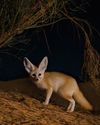Rise of the killer hornets
BBC Wildlife
|April 2025
Asia's yellow-legged hornet has a toehold in Britain but we're keeping it at bay - for now

IT'S EARLY APRIL AND YELLOW-LEGGED, or Asian, hornet queens that managed to evade the nest-destroyers from the UK's National Bee Unit (NBU) last year are just waking up from their long winter hibernation.
Though it is native to the generally much warmer climate of south-east Asia, the yellow-legged hornet is extremely adaptable and has found continental Europe and the UK much to its liking since it arrived in France back in 2004.
A hornet queen spends April building up her reserves by feeding on sugar-rich foods, such as tree sap and nectar. She also constructs the year's first nest from rotting wood, which she mixes with her saliva to create a hollow, papier-mâché-esque ball. When that's ready, she'll lay up to 2,000 eggs, feeding them once they hatch.
And that's when she starts to wreak havoc. Because yellow-legged hornets feed voraciously on other insects, including domesticated honeybees, to satisfy their brood's requirement for protein. One nest of larvae can consume up to 11kg of insects, and it's long been feared - ever since the species was first officially recorded in Britain in 2016 - that the yellow-legged hornet could have a devastating impact not just on honeybees, but also on other pollinators, such as solitary bees, hoverflies and even bumblebees, should it become established.
Peter Kennedy, a research fellow at the University of Exeter who has been studying yellow-legged hornets since 2016, says Kennedy and his colleagues have carried out a study, due to be published this year, in which they analysed the DNA of hornet larvae to identify what the adults have been predating. They found evidence of bumblebees, even though they have also published a study that shows bumblebees - unlike other insects - are often able to escape hornet attacks.
Denne historien er fra April 2025-utgaven av BBC Wildlife.
Abonner på Magzter GOLD for å få tilgang til tusenvis av kuraterte premiumhistorier og over 9000 magasiner og aviser.
Allerede abonnent? Logg på
FLERE HISTORIER FRA BBC Wildlife

BBC Wildlife
"I was terrified the elephant would ram us"
African elephant in Kenya
2 mins
January 2026

BBC Wildlife
ALL YOU EVER NEEDED TO KNOW ABOUT THE Fennec fox
THE FENNEC FOX IS THE SMALLEST fox in the world, with a body length that can be as little as 24cm.
3 mins
January 2026

BBC Wildlife
INTO THE PLASTISPHERE
A unique synthetic ecosystem is evolving in our oceans – welcome to the plastisphere
7 mins
January 2026

BBC Wildlife
“More than half of all animal life exists in a parasitic relationship, and all life lives in symbiosis”
Our survival depends on species evolving to live together - but some relationships take dark turns
7 mins
January 2026

BBC Wildlife
Are animals able to dream?
SLEEP IS A MYSTERIOUS THING. FOR A long time, we weren't sure why we do it.
1 mins
January 2026

BBC Wildlife
Does a cuckoo know it's a cuckoo?
ABSURD LITTLE BIRDS ACROSS THE world lay their eggs in the nests of other species, leaving the hapless parents to raise a changeling at the expense of their own offspring.
2 mins
January 2026

BBC Wildlife
Orcas killing young sharks
Juvenile great whites are easy prey for orca pod
1 mins
January 2026

BBC Wildlife
Ocean goes on tour
Acclaimed film touring the UK, backed by live orchestra and choir
1 min
January 2026

BBC Wildlife
Feisty bats hunt like lions
Winged mammals use a 'hang and wait' strategy to take down large prey
1 mins
January 2026

BBC Wildlife
SNAP-CHAT
Richard Birchett on magical merlins, wily coyotes and charging deer
2 mins
January 2026
Listen
Translate
Change font size

